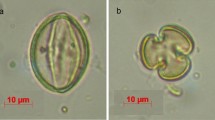Abstract
The closely related species, diploidAnthoxanthum alpinum Á. Löve etD. Löve and tetraploidAnthoxanthum odoratum L., have distinct distributions:A. alpinum is an arctic-alpine species, whileA. odoratum is a species of lower altitudes and more southerly latitudes. However, some authors suggest that both species are potentially able to maintain their populations in the distribution area of the other species.
Reciprocal transplant experiments in two mountain localities (one withA. alpinum, the other withA. odoratum) were carried out to study the survival and vegetative and generative reproduction of tussocks of both species in the area of distribution of the other species. The mortality of tussocks ofA. alpinum was higher in the “alien” locality, the life span of tillers was greatly reduced and the size of tussocks decreased considerably during the experiment compared to its “native” locality. These results suggest that there was a lack of favourable microsites forA. alpinum in the “alien” locality probably caused by the presence of strong competitors.A. odoratum flowered far less in the “alien” locality (both on tussocks and tillers) compared to the “native” one. These results suggest that environmental conditions are not suitable for the flowering ofA. odoratum in the “alien” locality.
We conclude thatA. alpinum could have been limited in extending its distribution into the area ofA. odoratum by the presence of strong competitors, whileA. odoratum could have been limited by its ability to reproduce by seed.
Similar content being viewed by others
References
Antonovics J. (1972): Population dynamics of the grassAnthoxanthum odoratum on a zinc mine.J. Ecol. 60: 351–365.
Antonovics J., Clay K. &Schmitt J. (1987): The measurement of small-scale environmental heterogeneity using clonal transplants ofAnthoxanthum odoratum andDanthonia spicata.Oecologia 71: 601–607.
Antonovics J., Ellstrand N.C. &Brandon R. (1988): Genetic variation and environmental variation: expectations and experiments. In:Jain S.K. &Gottlieb L.D. (eds.),Plant evolutionary biology, Chapman & Hall, New York, pp. 275–303.
Antonovics J. &Primack R.B. (1982): Experimental ecological genetics inPlantago. VI. The demography of seedlings transplants ofP. lanceolata.J. Ecol. 70: 55–75.
Böcher T.W. (1961): Experimental and cytological studies on plant species VI.Dactylis glomerata andAnthoxanthum odoratum.Bot. Tidskr. 56: 314–335.
Bogenrieder A., Bühler M. &Härringer P. (1993):Anthoxanthum odoratum L. undAnthoxanthum alpinum (Á. etD. Löve) am Feldberg (Schwarzwald). Ein Beispiel für Höhenvikarianz.Carolinea 51: 41–50.
Davies M.S. &Snaydon R.W. (1976): Rapid population differentiation in a mosaic environment. III. Measures of selection pressures.Heredity 36: 59–66.
Felber F. (1986): Distribution des cytodémes d’Anthoxanthum odoratum L. s. lat. en Suisse. Les relations Alpes — Jura.Bot. Helv. 96: 145–158.
Felber F. (1988): Distribution des cytodémes d’Anthoxanthum odoratum L. s. lat. en France et dans les régions limitrophes.Bull. Soc. Bot. France 135: 281–293.
Fisher L.D. &van Belle G. (1993):Biostatistics. A methodology for the health sciences. Wiley-Interscience Publication, John Wiley & Sons, Inc., New York.
Grant M.C. &Antonovics J. (1978): Biology of ecologically marginal populations ofAnthoxanthum odoratum. I. Phenetics and dynamics.Evolution 32: 822–838.
Harris W. (1970): Genecological aspects of flowering and vegetative reproduction inRumex acetosella L.New Zealand J. Bot. 8: 99–113.
Hedberg I. (1967): Cytotaxonomic studies onAnthoxanthum odoratum L. s. lat. II. Investigations of some Swedish and of a few Swiss population samples.Symb. Bot. Upsal. 18(5): 1–88.
Hedberg I. (1969): Cytotaxonomic studies onAnthoxanthum odoratum L. s. lat. III. Investigations of Swiss and Austrian population samples.Svensk Bot. Tidskr. 63: 233–250.
Hedberg I. (1986): The genesis of tetraploidAnthoxanthum odoratum.Symb. Bot. Upsal. 27(2): 147–154.
Hedberg I. (1990): Morphological, cytotaxonomic and evolutionary studies inAnthoxanthum odoratum L. s. lat. — a critical review.Sommerfeltia 11: 97–107.
Herben T., Krahulec F., Hadincová V. &Kovářová M. (1990): Small scale dynamics in a mountain grassland. In:Krahulec F., Agnew A.D.Q., Agnew S. &Willems J.H. (eds.),Spatial processes in plant communities, SPB, The Hague, pp. 173–184.
Herben T., Krahulec F., Hadincová V. &Skálová H. (1993a): Small-scale variability as a mechanism for large-scale stability in mountain grasslands.J. Veg. Sci. 4: 163–170.
Herben T., Krahulec F., Hadincová V., Kovářová M. &Skálová H. (1993b): Tiller demography ofFestuca rubra in a mountain grassland: seasonal development, life span, and flowering.Preslia 65: 341–353.
Herben T., Krahulec F., Hadincová V. &Pecháčková S. (1994): Is a grassland community composed of coexisting species with low and high spatial mobility?Folia Geobot. Phytotax. 29: 459–468.
Johnson M.P. &Cook S.O. (1968): “Clutch size“ in buttercups.Amer. Naturalist 102: 405–411.
Krahulec F. et al. (1996): Louky Kronoš: rostlinná společenstva a jejich dynamika (Grasslands of the Krkonoše Mountains: plant communities and their dynamics).Opera Corcontica 33: 3–250.
Mayová M. (1982): Příspěvek k řešení problematikyAnthoxanthum odoratum L. s.l. se zvláštním zřetelem kAnthoxanthum alpinum Á. etD. Löve (A contribution to the study ofAnthoxanthum odoratum L. s.l. with special emphasize onA. alpinum Á. etD. Löve). Ms., Dipl. Thesis, Dept. Bot. Fac. Sci. Univ. Carol., Praha.
Melzer H. (1986): Notizen zur Flora des Burgenlandes, von Nieder- und Oberösterreich.Verh. Zool. Bot. Ges. Österreich 124: 81–92.
Platenkamp G.A.J. (1990): Phenotypic plasticity and genetic differentiation in the demography of the grassAnthoxanthum odoratum.J. Ecol. 78: 772–788.
Platenkamp G.A.J. &Foin T.C. (1990): Ecological and evolutionary importance of neighbors in the grassAnthoxanthum odoratum.Oecologia 83: 201–208.
Rozmus M. (1958): Cytological investigations onAnthoxanthum alpinum L. et L., a new species of the flora of Poland.Acta Biol. Cracov., Ser. Bot. 1: 171–184.
STATSOFT Inc. (1996):Statistica for Windows (Computer Program manual. Version 5). Statsoft Inc., Tulsa.
Stebbins G.L. (1957):Variation and evolution in plants. Ed. 3. Columbia University Press, New York.
Stebbins G.L. (1984): Polyploidy and the distribution of the arctic-alpine flora: new evidence and a new approach.Bot. Helv. 94: 1–13.
Tutin T.G. et al. (1964–1980):Flora europaea 1–5. Cambridge University Press, Cambridge.
Author information
Authors and Affiliations
Rights and permissions
About this article
Cite this article
Flegrová, M., Krahulec, F. Anthoxanthum odoratum andA. alpinum: Life history parameters at two different altitudes. Folia Geobot 34, 19–31 (1999). https://doi.org/10.1007/BF02803074
Issue Date:
DOI: https://doi.org/10.1007/BF02803074




